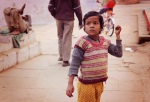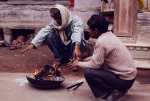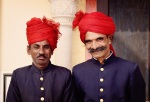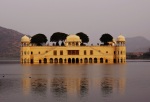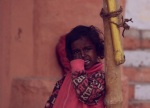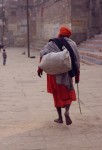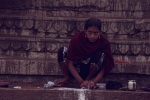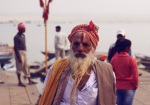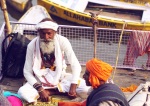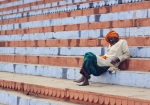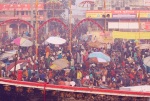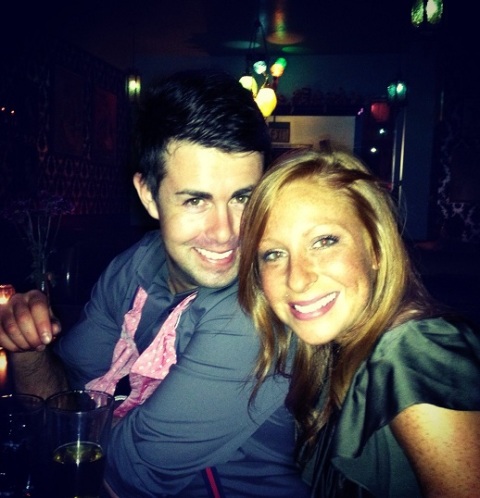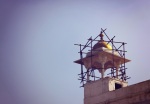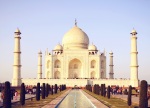Farewell, bidā’ī, बिदाई
February 14, 2013 § Leave a comment
January 28th:
As my time here in India is coming to a close, I’ve thought long and hard about how I can sum up the country, if not on paper, then at least in my own mind. As I walked the streets of Mumbai tonight, watching families huddled on the sidewalks, preparing their meals, putting their children to bed, and washing their clothes, I wondered about their struggles, sorrows, and triumphs: their stories. It would take a diligent lifetime to fully understand most countries, but even that wouldn’t suffice for a place such as this.
India is a world all its own. One minute you love it, the next you don’t. A trip here is like experiencing all of life’s greatest emotions, one right after the other, and sometimes all at once. There are extreme highs, followed by extreme lows. One second you’re happy, the next you’re sad. What you see is what you get. It’s not sugar coated or watered down. And while in many ways that brutal honesty is almost something beautiful, for so much of what we see at home, in the first world, is an illusion, it isn’t always easy to swallow.
The best way I can put it is that India is indescribable. Surely nowhere else in the world can have such a diverse and interesting culture, at such intensity, in such a small space. Over a billion people are squeezed into a country much smaller than other giants, and it is better understood as a continent, than just a single country. North to south, east to west, and everywhere in between, the country alters, changes, and never fails to grab your attention. From the mind-blowingly crazy collection of beliefs and traditions that is Hinduism, with its monkey gods, rat temples, and three-headed elephants. To also having one of the largest Muslim populations, where you can often hear the call to prayer from nearby mosques. And let’s not forget about the millions of Sikhs, Christians, Buddhists, Jains, Jews, and Catholics in the mix. A lifetime of investigation would barely scratch the surface. Just names of religions do not demonstrate the complicated social systems and hierarchies that are intertwined with the spiritual aspect, and the delicate web that is weaved by the mixing of so much, so intimately.
Ultimately it is a country of riddle, wonder, and great contradiction. It has been a privilege to spend the past few weeks here, attempting to unravel even the tiniest of threads. Despite the many challenges with just about everything I attempted to do – and I do mean everything – along with a number of underlying traits of the national psyche that I find very hard to reconcile, I am leaving this place exhausted, but enchanted. India isn’t a trip or a vacation, it’s an experience. One that I feel very fortunate to have had…
Pretty Palolem
February 13, 2013 § Leave a comment
January 26th:
Goa: it’s green, glistening, and absolutely gorgeous. Silky sand, crystalline shores, and temperatures that soar upwards of ninety are just a few reasons I set my sights on the coastal state. I wanted to slow it down – way down.
The seaside town of Palolem is nestled along a small crescent beach, and was one of Goa’s undiscovered gems with very few tourists and facilities to offer them, as little as ten to fifteen years ago, when things were booming up north. Fast-forward to now, and it’s no longer hidden (nowhere is!), but remains one of the sleepier, and in my opinion, extremely stunning spots. If you want to avoid the ultra-hippies who bathe in patchouli oil, and are obsessed with their pooja prayers and mantras, as well as the trance seeking, drug taking, everything’s a party crowd, then this is your spot. Palm trees, tea plantations, and coco-huts. What more can you ask for?
I spent the first few nights inland, but eventually made my way to the shores, and was lucky enough to find the perfect thatched-roof hut. With an adorable porch, fit with a hammock, I was able to spend my days swaying like the palms around me, soaking up the sun, going for long walks, and peddling through the countryside. It was the perfect place to sit and contemplate all that has transpired. Not just here in India, but beyond that. I’m a firm believer that it’s healthy to take a step back and asses your circumstances, every so often: where you are, where you’ve been, and where you want to go. Who’s in your life, why do they matter, and do you do unto them, as you wish done to you.
In India, spirituality and religion are apart of everything you touch, taste, feel, and hear. It’s all around you. Hindus believe that earthly life is cyclical: you are born again and again, the quality of these rebirths being dependent upon your conduct in previous lives – your Karma. It’s your actions, not your words that define you. Living a righteous life and fulfilling your dharma (social duty) will enhance your chances of improving your circumstances in the next life. Alternatively, if enough bad karma has accumulated, rebirth can take animal form, and if that shall happen, there’s no going back or saying you’re sorry… your soul must move on, and carry out its sentence.
Now, I am not Hindu. I don’t believe in the Brahman, Vishnu, or Shiva. But I do believe that our time on this earth matters – that how we treat each other truly matters – and that we will be held accountable for our actions, whether it’s in this life, or the next…
Pushkar
February 12, 2013 § Leave a comment
January 24th:
Pushkar has a magnetism all its own. It hums with prayers, chants, drums and gongs. Once you make it up and over the Snake Mountain, you break away from the crowded streets and clouded senses, and are overcome with calm.
As you make your way down the other side, you descend on milky blue temples and a tiny town, hugging a small lake that is said to have appeared when Brahma dropped a lotus flower. This is India at its finest. Children run across rooftops flying kites, shop-keepers are happy to help, but don’t apply pressure, and locals run to their windows to say hello and wish you well. A little slice of heaven.
The bus ride from Jaipur was four hours of rocky, winding roads, and blaring horns. Passengers and luggage were tossed about carelessly. Sharp turns, slamming breaks and darting animals, made it feel as though we were narrowly cheating death with each passing breath. Luckily, I was in good company, and it helped to pass the time and act as a distraction. I met three lovely ladies from Zimbabwe who were such a joy.
I crossed into Zimbabwe while visiting Victoria Falls, but thirty minutes standing on a bridge was as far as I made it. I would have loved to venture further into the country, but it wasn’t in the cards that time around. Chances are, if you’ve heard anything about Zim, it hasn’t been good. Civil war, a tanked economy, and home to one of the worst presidents you can possibly imagine: Robert Mugabe. There have been some really interesting documentaries and well written articles about what it’s like to grow up as a “White African” there, especially if you settle in the country and own a farm.
For these three ladies (Jess, Jess, and Jen) they grew up in the city and didn’t face the same dangers as those in the farming community, but it certainly wasn’t all sunshine and rainbows. Racism is a street with many, many lanes, going every which way. And while most would deem their home unsafe, they felt more unsettled here in India, than at home or any other place they’d visited previously.
While listening to their stories about being scammed and mislead in Delhi, a man working on the bus approached me. He claimed that my guesthouse phoned to say that I short paid my bill, and that I still owed 750 rupees! You should have seen the look on my face. The four of us starting laughing hysterically due to his timing. It was perfect – absolutely perfect. Our amusement only exacerbated the situation, though. He threatened to keep me on the bus, hold my bag, and a few other things that I didn’t understand. I think he even mentioned my arrest, but I can’t be certain. Seeing as how I wasn’t going to budge – I would have sat there all day out of principal – he eventually backed down and retreated to his seat up front. Never a dull moment. Someone is always trying to heckle the rupees right out of your pocket. Luckily, I am not one to be pressured easily and threats often have the opposite affect, even in foreign territory, so I’m pleased to report that I haven’t been taken to the cleaners… yet.
My stay in Pushkar was short, but sweet. I spent most of my time with the three J’s. We wandered the streets, drank a boat load of tea, and found the most divine rooftop terrace to close out our nights. If it wasn’t for a flight to catch, I would have stayed a few extra days, but after only two nights, it was back on the bus.
Bus rides are such a mixed bag. You never really know what you’re getting until you hop on. I thought I was going on the slightly nicer “tourist” bus, but apparently that wasn’t the case; I was going local, whether I wanted to or not. By the time my stop rolled around, all of the seats had been taken and it was down to the aisle. I have no problem with standing, in fact, sometimes I prefer it, but when it’s in a pile of puke, with nowhere for my bags, it makes things a little rough. Just a little…
Running to Rajasthan
February 11, 2013 § Leave a comment
January 22nd:
Kumbh Mela. The first time I heard those words I said to myself, “Kumba what? Kumba Melon? And I care because why?” That was before I understood the meaning. For Hindus, which make up the vast majority of India’s population, Kumbh Mela is a time of celebration! The origins of the festival go back to the battle for supremacy between good and evil. In the Hindu creation myths, the gods and demons fought a great battle forKumbh: a pitcher containing the nectar of immortality. Vishnu got hold of the container and floated away, but in flight, four drops made their way down to earth and landed at Allahabad, HardiwarI, Nasik, and Ujjain.
If crowds worry you, stay away. This one’s big. Very big. Held four times every twelve years (2013 being a winner!) in the cities mentioned above, Kumbh Mela is said to the be the largest religious gathering on the planet, drawing crowds between 40-70 million. Try and wrap your head around that. I can’t.
Seeing as how Varanasi lands hot on the trail to Allahabad, the population was increasing at a rapid rate. After three nights it was time to hit the road. I came, I saw, I conquered. I was pining to get out. Buses and trains were experiencing major delays, so I took to the skies and headed east to the great state of Rajasthan.
After two flights, long delays, and a few stressful moments, I landed in Jaipur, also known as “The Pink City”, and the state’s capitol. Feeling relieved to have some breathing room, I found myself a decent place to say and settled in for the night. After only a few hours of sleep, I awoke with a fever that soared, and stomach that turned. I was feeling ill. Very ill.
I spent that night and following day curled up in a ball, moving between the bed and bathroom floor. My mind was plagued with images of Vietnam and the sickness that ensued, some six years ago. I begged, pleaded and prayed, that what happened there, not happen here. I didn’t have it in me to go through it again.
After a second night, with slight improvements, I forced myself up and out of the room. My first stop was to a local pharmacy. I was given three prescriptions to take for five days. I have no idea what they were, only that I spent 100 rupees, which is equivalent to $2. I can’t even buy a bottle of Aspirin for that.
As much as I wanted (and needed) to hide away, the clock was ticking. With a bus to catch the next morning, it was now or never. I made my way through the old city, which was a pleasant stroll. I visited City Palace, stopped for Chai, and posed for pictures. Monkeys rule the area and I was harassed more than once. They beg, screech, and scratch their nasty rear ends. They are foul little things, and sneaky too. Very, very sneaky. Africa taught me to never trust a monkey. They’ll take you for all you’ve got.
When I finally ran out of steam, I hoped in a tuk-tuk and headed back. Unfortunately, it wasn’t without a fight. The entire twenty minute ride was spent arguing with the driver about why I didn’t want to have a drink or get high. Is all I could hear was, “Miss, just one beer… or two. Miss, let’s smoke. Come on, Miss. Miss, I take you, not too long… just trust me. Why don’t you trust me!?!” At one point he even pulled over in an attempt to be more serious and persuasive. As if that was going work!?! Over my dead body. If that man thought I was going anywhere other than my hotel, he was out of his f-ing mind. I nearly lost it. I told him he better get his “helicopter” (his words, not mine) moving or he’d be out 60 rupees. Seeing as how money matters – here more than most – he swallowed his pride and zipped his mouth. Thank god. If only he had swallowed the key…
Street Life
February 11, 2013 § Leave a comment
January 19th:
It should come as no surprise when I say that India is, well, dirty. And by dirty, I mean filthy. I’ve seen my fair share of waste, pollution, piled up plastics, but the amount here is astonishing.
India’s trash goes on the street. Garbage collected from homes, hotels and food stalls, seems to be thrown on the nearest corner. Animals (cows, buffalo, goats, dogs and monkeys) who wander the streets defecate and urinate as needed. When it rained I found myself trudging through a sewer. Anything goes here. Men spit their paan and perform “farmer’s blows” to alleviate nasal congestion. Pant-less babies are free to relieve themselves as needed. After consuming chai or a snack, the garbage is tossed to the road without a second thought. Bus, car and train windows are used to purge trash. Makeshift urinals are created whenever there is a running sewer or just a darkish corner – usually the latter. The smells of urine, feces, rotting food (which is only avoided by street animals after it is particularly rancid), mud and dust fill the air around the worst of India’s streets. So it follows that the street dwellers are viewed as the lowest of low here.
Street children and stray dogs are two of the street’s main inhabitants. Left to wander, they are surprisingly territorial and stick to a particular thoroughfare or intersection. Fending for themselves, the instinct to survive is dependent on one thing: the need for food.
While walking through the streets, a small boy and dog caught my eye. What surprised me the most was the similarities between the two. They stood out of the way of traffic, virtually invisible to all passing by. They followed dropped items to see if any were edible. They lingered near food stalls and nudged people with their hands. Alert, their eyes darted back and forth, focused on filling their needs. They shuddered when men came too close or raised a hand. They were dirty, and looked as though they had skin infections, but most of all, they were alone. My heart crumbled. I wanted to whisk them away and make it all better, but alas, it isn’t that simple…
My usual stance on avoiding giving to children who are begging or selling has been challenged here more than anywhere. My reason for refraining has always been that I don’t want to help children be successful in these activities, as they will avoid going to school in order to continue their practice. But in India, free public education is not available, and school is often not an option. So what happens to all of the street children? Are they viewed as being on par with dogs? How does a child, who is stimulated only by their daily struggle for food have a fighting chance? They don’t.
Stray dogs are particularly rampant here. They, unlike children (thankfully), breed at astonishing rates, and the next generation of street dogs can be seen huddling in cracks of pavement. The puppies are precious in their precocious innocence, but are often already leery of human contact. They, like their parents, develop skin conditions, have ticks, fleas and injured limbs, and will likely go their whole lives without a second glance.
India is amazing in its own way. The historical relics, religious sites, and people are really lovely. However, the lack of sanitation and the treatment of its neediest inhabitants, who are all around, just like the trash on the street, feels too much to bear at times…
This is a place that plays on your heartstrings and shrinks you down in size.
Streets of Varanasi
February 11, 2013 § Leave a comment
January 18th:
The city, especially the old quarters, has a beat all its own. Navigating the narrow mess of alleyways was a challenge, but I did my best to follow rule number one of safe, solo travel: always look like you know where you’re going… or at least attempt to.
My bluff was called early on when circling about. I passed the same group of guys two, maybe three times, and eventually caved. They were more than happy to help. After walking me to the restaurant, I was starting to change my tune, thinking maybe, just maybe, I had finally encountered some good samaritan’s who wanted nothing in return. Not so fast. As soon as I reached my destination I heard the famous words, “If you have some time after, you come to see my shop. You don’t have to buy anything, just look. Beautiful, beautiful things. I help you, you help me, you see?” And there it was. Life in Varanasi means survival, and for shop-keepers in this touristy town it means offering one service in exchange for another. I’ll show you the way, if you help me fill my pockets. Simple as that.
While roaming around, I encountered many curious crowds, but instead of wanting to know where I was headed or which country I’m from, they were more concerned with my hair. Yes, that’s right, my copper top. Now, to be fair, this wasn’t the first time my hair has attracted attention. While growing up, I could pretty much guarantee that a trip to the grocery store would result in middle aged women oohing and awing over my curly mop. At the age of six, I was a real life, walking, talking, breathing Annie, freckles and all. Only I didn’t live in an orphanage or have a dog named Sandy. In a city that receives an estimated 200,000 foreign tourists per year, you’d think at least a handful of those would be Ginger’s.
While the streets of Varanasi were moving at top notch speeds, I found some relief on the river. From the confines of a small rowboat I could breathe easy for a nominal fee. A first row seat to all of the action without any of the hassle for just $2.25. That’s money well spent.
The Great Ganges
February 8, 2013 § Leave a comment
January 17th:
Varanasi: brace yourself. It’s one of the most blindingly colorful, unrelentingly chaotic, and unapologetically indiscreet places on earth. No joke. This is the real deal, folks. It’s rude, crude, and out of control. Give it a little time, let the dust settle, and you just might want to stick around for a few days, as I did. After all, it’s the City of Life, or so I am told.
Life in Varanasi isn’t confined to human life. Dogs, cows, buffaloes, goats, birds and cats survive, reproduce and die in and along the great Ganges River. Cows navigate narrow passageways and feast on vegetables and waste, left on the streets by many. Buffaloes bathe in the sacred waters alongside men washing laundry, and the many pilgrims who have come from all over, to line the ghats, in hopes of washing away a lifetime of sins. Apparently one dip, splash, or sprinkle in the “sacred” water is all it takes to be clean as a whistle!
But there is another side to Varanasi, and that is death. For Hindus, the sacred Ganges River is considered a most auspicious place, and to die here means that the person has escaped the cycle of rebirth and reincarnation, and is granted instant salvation. The elderly contemplate life at its riverbanks. Families relocate here near the time of imminent death of a loved one, and once death has come, they prepare for cremation.
Cremation is big business. At the burning ghats, piles of wood are ready for a family to purchase. It is a science to determine how much wood is needed to burn an entire corpse. Male family members stand around and participate in the activity, while women are not seen, but are said to be watching from afar. Bodies, draped in orange fabric are carried through the streets in procession to the ghat. Feet and sometimes faces are exposed. The flames billow and reach for the sky, while smoke wafts into the eyes of onlookers. Once the body has turned to ash, men wade with sieves full of it, shaking the remains into the Ganges River, removing any trinkets left behind. Children and pregnant women are not allowed to be cremated, therefore when they pass, they are weighted down and pulled away from shore. At some point, they will likely resurface and drift downstream, but here, that isn’t cause for concern, as it’s simply part of the cycle…
Hurry Up and Wait: Agra to Varanasi
February 8, 2013 § Leave a comment
January 16th:
After two days in Agra it was time to hit the road. With my bags packed, I took a Xanax (to help me sleep, of course!) and caught a ride to the train station, with my sights set on the “holy” city of Varanasi, some thirteen hours away.
I arrived just before nine o’clock to discover my train had been delayed by nine hours, making my new departure scheduled for six in the morning – woohoo! Nine hours!?! How does that even happen? I mean, I can understand three, five… but nine!?! Feeling a temper tantrum coming on, I marched out to the road, coughed up another 100 rupees, and back into town I went!
Instead of returning to my previous digs, I stopped to check out another place closer to the station, where I ate earlier in the day. Boy am I happy I did. Nice folks, a relatively warm room, and hot water – yay!!! It’s amazing what a hot shower can do for your soul, especially since that was my first since arriving. As much as I wanted – and probably needed – I couldn’t bring myself to take a cold shower in a cold room prior to this, which means I was looking and feeling pretty scuzzy. Cold showers were practically a daily occurrence while in Africa, and often refreshing due to the heat, but that’s certainly not the case now.
I awoke just after four to prepare for my “overnight” journey, to discover the power had gone out while I was asleep. I was so tired the night before that I neglected to pack my things, so I had to scurry around the room with the help of my flashlight app. As much as I hate to admit it, my iphone has come in handy on many occasions. I really, really want to hate it, but it’s just so darn convenient! Ugg!
The guesthouse was pitch black and eerily quiet. I kept thinking someone was going to pop out around every corner, as I made my way down four flights of stairs. Fortunately I missed stepping in the dog poo waiting outside my door. It’s the little things that make your day.
The train arrived shortly after I, and I found myself assigned to a sleeper carriage. The trains here are hands down, the filthiest I’ve ever seen. If someone arrived expecting those on The Darjeeling Limited – all cute, cozy, and colorful – they’d be sorely disappointed. Apparently Wes Anderson has never ridden on one. He should check it out.
Each carriage is a never-ending line of thin, flimsy bunks, stacked three high. The colors inside are a mix of chipped blue paint, orange rust, and a nice layer of black grime. I was lucky enough to be placed near the toilet (squatter that dumps on the tracks), so the air smelled of human waste and a mix of spices from passing vendors. I was on the bottom with two large windows, which made the morning freezing, but afternoon and evening pleasant.
The ride, which I had initially assumed would be long and uncomfortable, actually turned out great. I met some really nice people (two girls from Korea, and a guy from London), which helped to pass the time! The Londoner, Adam, is doing exactly what I did a couple of years ago: quit his job, bought a one way ticket, and doesn’t have a plan. That gave us plenty to talk about.
The four of us laughed, swapped stories, and shared in each others hunger pains. We all neglected to pack snacks, and the lunch that we ordered three hours in, still hadn’t arrived, twelve hours later, when we reached our destination! A fifteen hour train ride with no food is not a good idea. Lesson learned. Next time I’m stocking up!
Looking back, I’m really happy the train was delayed. Had it left at its scheduled time, all aboard would have been sleeping – or at least attempting to – therefore I might not have met them, and I would have missed out on the scenery along the way. It was really interesting to pass through the tiny towns and villages. I could have done without the hoards of people lining the tracks to go No. 2, though. Wouldn’t you at least want a bush!?! I certainly would…
I still have yet to take train photos – in due time. These were snapped with my handy-dandy iphone. See, there I go again. I’m never going to rid myself of this thing, am I? Grrr.
A New Appreciation
February 8, 2013 § Leave a comment
January 15th:
In a country of 1.2 billion, it’s hard to imagine that one might feel lonely, but there are moments here, when it’s difficult to feel anything but. Just like everything in life, traveling alone has its positives and negatives. The beauty is that you’re far removed from your comfort zone, which is challenging, but strengthening in the long run. When you wake, there’s only you to decide where to go, and what to do. Everything rests in your hands. In some ways, that temporary independence is exciting – maybe even inspiring – but it comes at a price, for there is always a trade off.
There are moments when you wish for someone to lean on, to laugh with, or to simply say, “Did you see that!?!” And when time passes, and things become hazy, you can help each other fill in the blanks and keep the memories alive.
This time around, traveling holds a new meaning, for I’m no longer searching, reaching, or running. I love my life. I’m simply here to see and experience, and hopefully through that, I’ll grow in some way, and return feeling more in tune with myself and the big, wide world we live in.
After all this time, I finally have the answer to my question: where is home? Home is with the person sound asleep on northeast tenth. Inside that corner apartment, we cook each other meals, finished each others sentences, and come up with silly handshakes. He reads me stories, while I pack him lunches, and we often leave notes in pockets and purses.
While we haven’t always treated each other the way we should, we do now, and that’s all that matters. I couldn’t possibly be happier, and it’s a beautiful thing to know that it’s shared.
Traveling is wonderful, but what awaits me at home is even more so…
The Taj Mahal
February 7, 2013 § Leave a comment
January 13th:
I don’t know about you, but when I think of the Taj Mahal, my mind conjures up images of Persian princes, magic genies, and flying carpets. I can pretty much hear A Whole New World blaring loud and clear. While a visit isn’t quite like fulfilling your Aladdin dreams, the Taj itself it pretty impressive, if I may say so. Standing there, looking up at this magnificent structure, I could practically wipe the drool from my chin; it’s that f%$#ing amazing. Yep, I said it. It really is. Suddenly I wanted to retract my statement about turning me into ashes and calling it good. Nope, not anymore. I want the whole nine yards: minarets, marble, fountains, you name it – something you can see from miles away. Better start saving those precious pennies, Misch – wink, wink!
Sadly, due to it’s ever increasing popularity, The Taj Mahal and Disneyland are one in the same. Crowds of people, crying children, and long lines. Oh, and here’s a fun little fact for you: the entry for Indians is 20 rupees, which is equivalent to about 25 cents; the charge for foreigners is 750 rupees, which is close to $15. Hmmm. Don’t get me wrong. I’m totally for charging us a little extra, but $14.50!?! Seems like a racket to me, but then again, maybe that’s just good business. After all, they do receive an estimated two-three million visitors per year. As they said in Field of Dreams, “If you build it, they will come”, and clearly that’s the case, whatever the cost.
The Taj was built by Mughal emperor Shah Jahan in memory of his third wife, Mumtaz Mahal, who died giving birth to their fourteenth child. Construction began in 1632 and the main mausoleum was completed in 1648, but it took an additional five years to complete the surrounding buildings and garden. It is said that the price tag was over thirty-two million rupees during that time, and over one-thousand elephants were used to transport the materials, which came from all over India, and several neighboring countries.
Soon after completion, Shah Jahan was overthrown by his son, and placed on house arrest in Agra Fort (also amazing). Seeing as how his son had half a heart, he made sure his father’s quarters included a view of the Taj, so he could admire from afar. When he passed, he was buried inside the mausoleum, next to his wife.
Unfortunately for me, photographing this beast was a difficult task due to the crowds, smog, and areas off limits. I took what I could, and then placed me camera back in my bag, so I could enjoy the moment, and appreciate the opportunity to be in the presence of something so beautiful…











